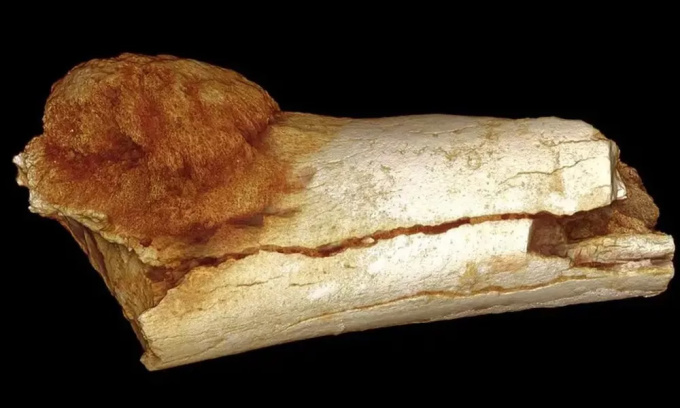The earliest evidence of cancer in humans belongs to an individual who lived about 1.7 million years ago with a malignant tumor in his toe bone.

The oldest recorded case of cancer occurred 1.7 million years ago, in a tumour on the toe bone of an individual who was a relative of modern humans. Photo: Patrick Randolph-Quinney/UCLAN
Cancer may sound like a modern disease, but it has actually been affecting humans for a long time, Live Science reported on May 8. Scientists have found many prehistoric human remains that show the presence of cancer. So, what is the oldest recorded case of cancer?
The earliest evidence of cancer in humans belongs to a relative of modern humans who lived about 1.7 million years ago. The individual, likely a member of the Paranthropus robustus or Homo ergaster species, suffered from a malignant tumor in the bone of his left toe. Archaeologists discovered the skeleton in Swartkrans Cave, a limestone quarry in South Africa that is often called the “Cradle of Humankind” because it is home to the world’s largest concentration of remains of modern human relatives.
When comparing computed tomography (CT) scans of the toe bone fossil with modern images of osteosarcoma (a form of cancer that starts in bone-forming cells), researchers immediately recognized the characteristic cauliflower-like shape of malignant bone tumors, according to a study published in the South African Journal of Science in 2016.
Today, osteosarcoma is one of the most common bone cancers in humans and can occur at any age, although it is most common in children, adolescents, and young adults, according to the American Cancer Society. The age of the individual with cancer in Swartkrans Cave is unknown, but appears to be an adult.
According to another study published in the South African Journal of Science in 2016, experts discovered an even more ancient benign tumor in an individual of the Australopithecus sediba species, a relative of humans that lived 1.9 million years ago.
It's no surprise that the oldest recorded case of cancer was in bone, since organs, skin, and other soft tissues are more susceptible to decay than bone. "Bone is one of the few tissues that can survive in the fossil record," says Bruce Rothschild, a vertebrate paleontologist at the Carnegie Museum of Natural History.
However, even when fossils contain cancer, scientists often cannot see it with the naked eye and need further examination to confirm. The same is true of the toe bone cancer mentioned above.
"About a third of cancers will reveal themselves. But you need to do an X-ray to see if there's anything hidden in the bone. When it comes to bone, most pathologists today look at an X-ray before making a diagnosis of a tumor," Rothschild said.
The earliest known case of cancer in a hominin occurred 1.7 million years ago, but the first written record of cancer came much later. In 3000 BC, Imhotep—an ancient Egyptian mathematician, physician, and architect—wrote the Edwin Smith Papyrus, a “textbook” on physical injuries and surgical procedures.
In this document, he details 48 medical cases, including several studies of breast cancer. The Edwin Smith papyrus not only provides information about how the ancient Egyptians performed surgery thousands of years ago, but also provides some of the oldest evidence of cancer.
Thu Thao (According to Live Science )
Source link



























































































![[OCOP REVIEW] Tu Duyen Syrup - The essence of herbs from the mountains and forests of Nhu Thanh](https://vphoto.vietnam.vn/thumb/402x226/vietnam/resource/IMAGE/2025/6/5/58ca32fce4ec44039e444fbfae7e75ec)





Comment (0)